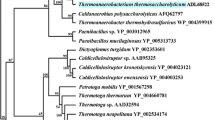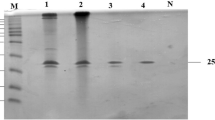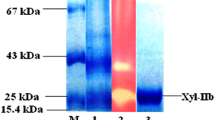Abstract
The xyn10B gene, encoding the endo-1,4-β-xylanase Xyn10B from Thermotoga thermarum, was cloned and expressed in Escherichia coli. The ORF of the xyn10B was 1,095 bp and encoded to mature peptide of 344 amino acids with a calculated MW of 40,531 Da. The recombinant xylanase was optimally active at 80 °C, pH 6.0 and retained approx. 60 % of its activity after 2 h at 75 °C. Apparent K m , k cat and k cat /K m values of the xylanase for beechwood xylan were 1.8 mg ml−1, 520 s−1 and 289 ml mg−1 s−1, respectively. The end products of the hydrolysis of beechwood xylan were mainly oligosaccharides but without xylose after 2 h hydrolysis.



Similar content being viewed by others
References
Chapla D, Pandit P, Shah A (2012) Production of xylooligosaccharides from corncob xylan by fungal xylanase and their utilization by probiotics. Bioresour Technol 115:215–221
Davies G, Henrissat B (1995) Structures and mechanisms of glycosyl hydrolases. Structure (London, England: 1993) 3:853–859
Deesukon W, Nishimura Y, Harada N, Sakamoto T, Sukhumsirichart W (2011) Purification, characterization and gene cloning of two forms of a thermostable endo-xylanase from Streptomyces sp. SWU10. Process Biochem 46:2255–2262
Gaffney M, Carberry S, Doyle S, Murphy R (2009) Purification and characterisation of a xylanase from Thermomyces lanuginosus and its functional expression by Pichia pastoris. Enzym Microb Technol 45:348–354
Jiang Z, Cong Q, Yan Q, Kumar N, Du X (2010) Characterisation of a thermostable xylanase from Chaetomium sp. and its application in Chinese steamed bread. Food Chem 120:457–462
Jun H, Bing Y, Keying Z, Daiwen C (2009) Functional characterization of a recombinant thermostable xylanase from Pichia pastoris: a hybrid enzyme being suitable for xylooligosaccharides production. Biochem Eng J 48:87–92
Khandeparker R, Verma P, Deobagkar D (2011) A novel halotolerant xylanase from marine isolate Bacillus subtilis cho40: gene cloning and sequencing. New Biotechnol 28:814–821
Lammirato C, Miltner A, Kaestner M (2011) Effects of wood char and activated carbon on the hydrolysis of cellobiose by β-glucosidase from Aspergillus niger. Soil Biol Biochem 43:1936–1942
Li L, Tian H, Cheng Y, Jiang Z, Yang S (2006) Purification and characterization of a thermostable cellulase-free xylanase from the newly isolated Paecilomyces themophila. Enzym Microb Technol 38:780–787
Mahuku GS (2004) A simple extraction method suitable for PCR-based analysis of plant, fungal, and bacterial DNA. Plant Mol Biol Rep 22:71–81
Pribowo A, Arantes V, Saddler JN (2012) The adsorption and enzyme activity profiles of specific Trichoderma reesei cellulase/xylanase components when hydrolyzing steam pretreated corn stover. Enzym Microb Technol 50:195–203
Shin JH, Choi JH, Lee OS, Kim YM, Lee DS, Kwak YY, Kim WC, Rhee IK (2009) Thermostable xylanase from Streptomyces thermocyaneoviolaceus for optimal production of xylooligosaccharides. Biotech Bioprocess Eng 14:391–399
Verma D, Satyanarayana T (2012) Cloning, expression and applicability of thermo-alkali-stable xylanase of Geobacillus thermoleovorans in generating xylooligosaccharides from agro-residues. Bioresour Technol 107:333–338
Windberger E, Huber R, Trincone A, Fricke H, Stetter KO (1989) Thermotoga thermarum sp.nov and Thermotoga neapolitana ocurring in African continental solfataric springs. Arch Microbiol 151:506–512
Zhang J, Siika-aho M, Puranen T, Tang M, Tenkanen M, Viikari L (2011) Thermostable recombinant xylanases from Nonomuraea flexuosa and Thermoascus aurantiacus show distinct properties in the hydrolysis of xylans and pretreated wheat straw. Biotechnol Biofuels 4:12
Acknowledgments
This work was financially supported by the Jiangsu Education (11KJA48001, CXZZ11_0526), the National Natural Science Foundation of China (Nos. 31370572, 31200564) and the Doctorate Fellowship Foundation of Nanjing Forestry University as well as the Priority Academic Program Development of Jiangsu Higher Education Institutions (PAPD).
Author information
Authors and Affiliations
Corresponding author
Additional information
Hao Shi and Yu Zhang contributed equally to this work.
Electronic supplementary material
Below is the link to the electronic supplementary material.
10529_2013_1392_MOESM1_ESM.tif
Supplementary material 1 Neighbor-Joining tree resulted from analysis of xylanases with 28 amino acid sequences. All these 28 amino acid sequences belong to GH10 family. Numbers on nodes correspond to percentage bootstrap values for 1000 replicates. (TIFF 4942 kb)
10529_2013_1392_MOESM2_ESM.tif
Supplementary material 2 Analysis of beechwood xylan hydrolyzed by Xyn10B. Supernatants of the reaction mixtures were applied on TLC silica gel plates (60 RP18 F254S, Merck KGaA). The plates were subsequently developed with three runs of n-butanol/acetic acid/water (2:1:1, v/v) followed by heating for 20 min at 100oC in an oven after spraying the plates with a methanol/sulfuric acid reagent (9:1, v/v). M, mixture of xylose, xylobiose, xylotriose, xylotetraose and xylopentaose, lane 1, 2, 3, 4: samples of beechwood xylan (5%, wt/vol) incubated with Xyn10B xylanase (1.5 U) for 0.5 h, 1 h, 2 h and 3 h, respectively. (TIFF 3864 kb)
Rights and permissions
About this article
Cite this article
Shi, H., Zhang, Y., Zhong, H. et al. Cloning, over-expression and characterization of a thermo-tolerant xylanase from Thermotoga thermarum . Biotechnol Lett 36, 587–593 (2014). https://doi.org/10.1007/s10529-013-1392-2
Received:
Accepted:
Published:
Issue Date:
DOI: https://doi.org/10.1007/s10529-013-1392-2




